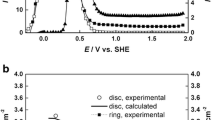Abstract
Mechanically polished zirconium electrodes were potentiodynamically polarized in phosphate buffer solutions of various pH values and in 0.5 lvl NaOH. The results show that the shape of the I-E curves is independent of the solution pH. At relatively low scan rates, oxygen gas evolution was observed. The oxide film thickness was calculated from the values of the charge consumed in the anodic process assuming 100% current efficiency for oxide formation below oxygen evolution (lower values for the current efficiency are assumed for potentials above oxygen evolution). Capacitance measurements, together with the calculated oxide thickness, were used to estimate values for the dielectric constant of the oxide. Two different values of the dielectric constant were obtained for the oxides formed in the range of potential below and above oxygen evolution. Also, higher dielectric constant values were obtained with increasing solution pH. Anion incorporation was assumed to increase the conductivity of the oxide films and, hence, decrease the dielectric constant. A two-layer structure is proposed for the anodically formed oxide on zirconium in aqueous solutions; an anion-free layer near the metal and an outer layer containing the incorporated anions.
Similar content being viewed by others
References
M. Pourbaix, ‘Atlas of Electrochemical Equilibria in Aqueous Solutions’, Pergamon Press, London (1966) p. 223.
T. P. Bondareva and V. M. Novakovskii, Zashch. Metal. 6 (l970) 207.
F. F. Faizullin and N. D. Mazurenko, Issled. Elektrokhim., Magnetokhim. Metod. Anal., no. 2 (1969) 136.
G. Kalyani, A. Pansa Reddy and K. S. Sastry, Z. Phys. Chem. 269 (1988) 201.
G. Kalyani and K. S. Sastry, Bull. Electrochem. 7 (1991) 22.
E. M. Patrito and V. A. Macagno, J. Electroanal. Chem. 371 (1994) 59.
Idem, J. Electrochem. Soc. 140 (1993) 1576.
J. L. Whitton, J. Electrochem. Soc. 115 (1968) 59.
J. A. Davies, B. Komeij, T. P. S. Pringle and F. Browm, ibid. 112 (1965) 675.
J. S. L. Leach and B. R. Pearson, Corros. Sci. 28 (1988) 43.
J. S. L. Leach and B. R. Pearson, Electrochim. Acta 29 (1984) 1263.
J. S. L. Leach and C. N. Panagopoulos, ibid. 31 (1986) 1577.
J. A. Bardwell and M. C. H. McKubre, ibid. 36 (1991) 647.
J. S. L. Leach and B. R. Pearson, ibid. 29 (1984) 1271.
J. C. Banter, J. Electrochem. Soc. 114 (1967) 508.
J. S. L. Leach, C. N. Panagopoulos and B. R. Pearson, The Electrochemical Society Extended Abstracts, Minneapolis, MN, 10–15 May (1981), Abstract 28, p. 91; J. S. L. Leach and C. Panagopoulos, 32nd ISE Meeting, Cavat, September (1981), Extended Abstracts, vol. II p. 1002.
N. Magnussen, L. Quinones, D. L. Cocke, E. A. Schweikert, B. K. Patnaik, C. V. Barros Leite and G. B. Baptista, Thin Solid Films 167 (1988) 245.
E. M. Patrito and V. A. Macagno, J. Electroanal. Chem. 375 (1994) 203.
M. W. Khalil, M. A. Abdel Rahim, Mat-wiss.u. Werkstofftech. 22 (1991) 260.
J. S. L. Leach and B. R. Pearson, Proceedings of the 7th International Congress on Metallic Corrosion, Rio de Janeiro, ABRACO (1978) p. 151.
G. T. Rogers, P. H. G. Draper and S. S. Wood, Electrochim. Acta 13 (1968) 251.
I. A. Ammar, S. Darwish and M. W. Khalil Z. Werkst. tech. 12 (1981) 421.
S. Darwish, M. W. Khalil, M. A. Abdel Rahim and I. A. Ammar, Mat-wiss.u. Werkstofftech. 20 (1989) 299.
T. Shibata and M. A. M. Ameer, Denki Kagaku 60 (1992) 494.
N. D. Mazurenko and F. F. Faizulline, Sb. Aspir. ab., Kazan. Gos. Univ., Khim., Geogr., Geol. (1970) 16–19.
E. M. Patrito, R., Torresi, E. P. M. Leiva and V. A. Macagno, J. E1ectrochem. Soc. 137 (1990) 524.
P. Meisterjahn, H. W., Hoppe and J. W. Schultze, J. Electroanal. Chem. Interfacial Electrochem. 217 (1987) 159.
L. Young, Proc. R. Soc. Lond. A 244 (1958) 41.
F. Di Quarto, A. Di Paola and C. Sunseri, J. E1ectrochem. Soc. 127 (1980) 1016.
J. J. Randall, W. J. Bernard and R. R. Wilkinson, Electrochim. Acta 10 (1965) 183.
M. S. El-Basiouny, A. A. Mazhar, F. El-Taib and M. A. Ameer, J. E1ectroanal. Chem. Interfacial Electrochem. 147 (1983) 181.
H. Takahashi, K. Fujimoto and M. Nagashama, J. Electrochem. Soc. 135 (1988) 1349.
I. Montero, J. M. Albella and J. M. Martinez-Duart, ibid. 132 (1985) 976.
A. Clearfield, Inorg. Chem. 3 (1964) 146.
Author information
Authors and Affiliations
Rights and permissions
About this article
Cite this article
Abdel Rahim, M.A., Abdel Rahman, A.A. & Khalil, M.W. Anion incorporation and its effect on the dielectric constant and growth rate of zirconium oxides. J Appl Electrochem 26, 1037–1043 (1996). https://doi.org/10.1007/BF00242198
Received:
Revised:
Issue Date:
DOI: https://doi.org/10.1007/BF00242198




